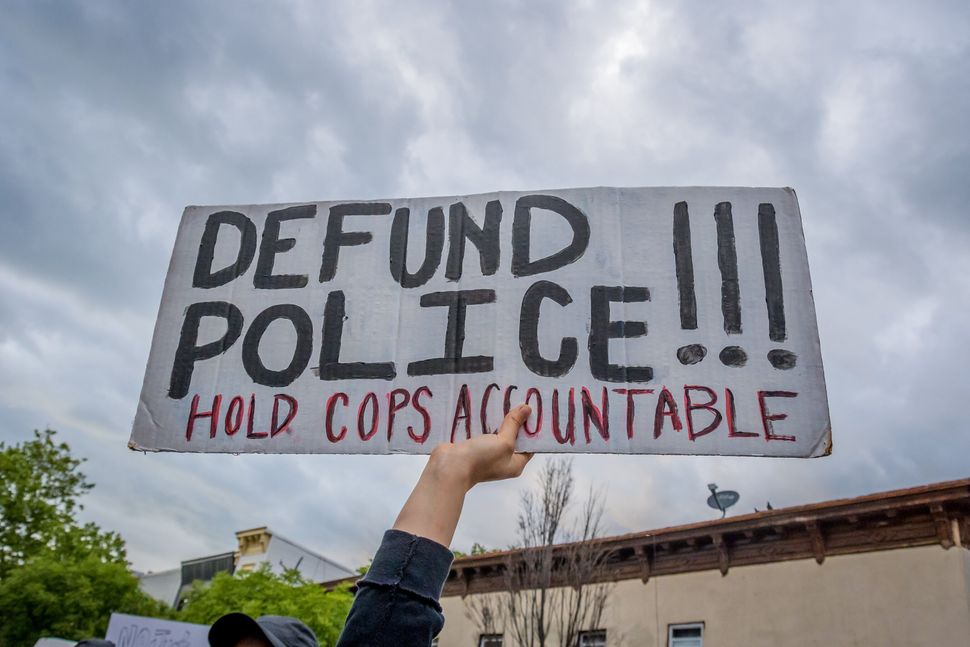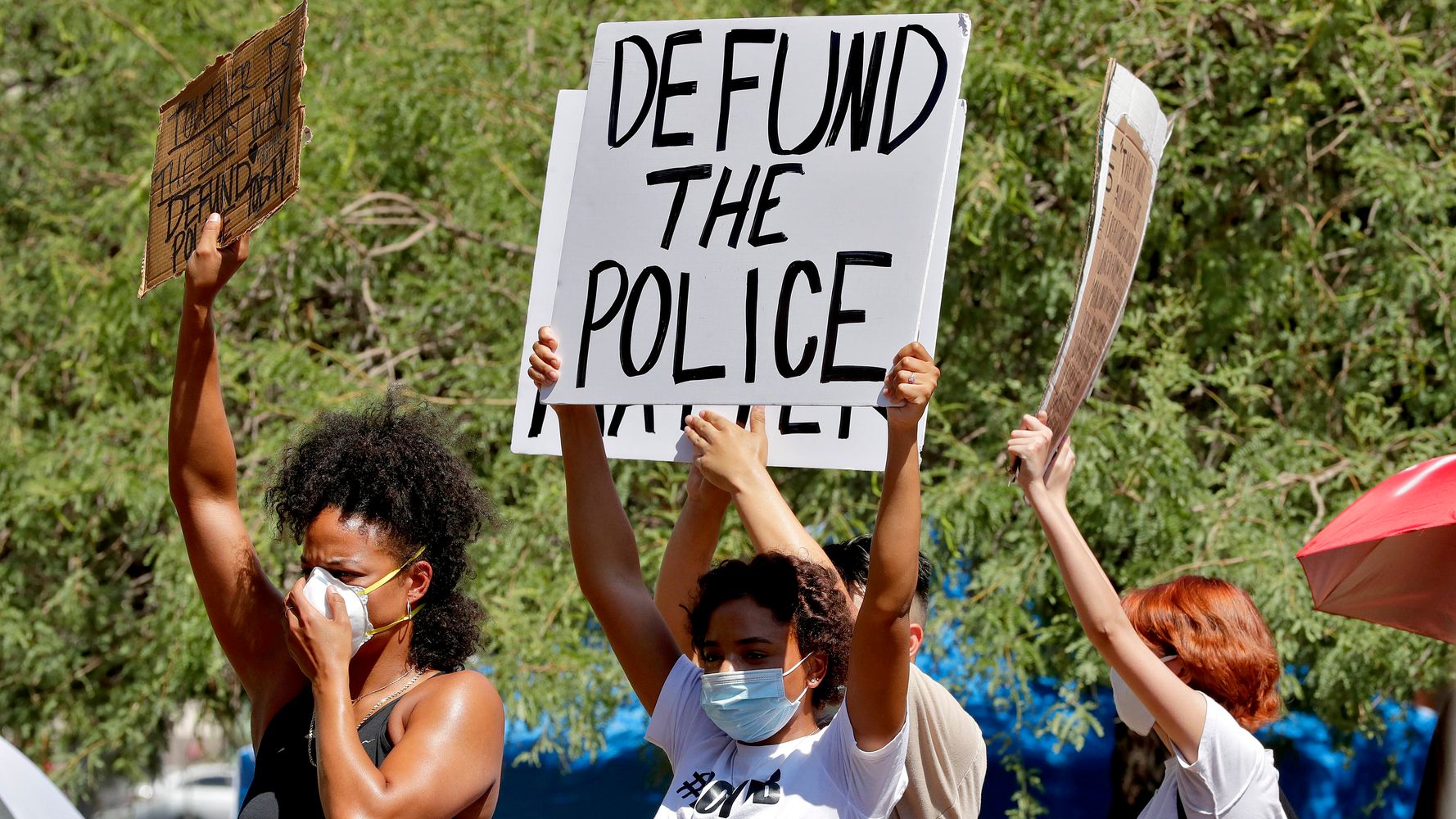[ad_1]
As activists demonstrate across the country to protest racism and police brutality, the call to “defund the police” has crystallized into a rallying cry. Instead of injecting more money into police department budgets, the argument goes, divert funds to community programs that directly support those individuals who most often end up in crisis situations with police: homeless people, people with mental illnesses, and those with substance use disorders.
It’s a compelling idea, backed by researchers, criminal justice reformists, and a small cohort of progressive lawmakers. Critics of this approach, however, derail the conversation using a time-honored method: pointing to female victims of violent crime. Who, they ask, will protect women against domestic abuse and sexual violence, if not the police? The implication is clear: If you don’t support police, you must not care about women’s lives.
Beneath this question lies a faulty assumption ― that police, as they are currently constituted, are equipped to protect women from abuse. It also ignores the testimony of leaders in the movement to end violence against women, who are reexamining their reliance on the criminal justice system and are actively seeking new approaches.
“There are survivors in many communities who don’t see law enforcement as a viable option for themselves and their families,” said Jacquie Marroquin, the director of programs at the California Partnership to End Domestic Violence. “The domestic violence field has been grappling with the question of who have we left behind? And that includes grappling with the unintentional consequences of the criminalization of abuse.”
Today, many domestic violence victims are already hesitant to involve the police, and often decide against it. Of the 847,230 known incidents of intimate partner violence in 2018, only 45% were reported to police, according to a Bureau of Justice Statistics report.
It does not take much imagination to work out why. Police don’t always treat victims with respect. They are not terribly good at determining who is the primary aggressor, and may arrest the victim or both people involved. And their very presence can be dangerous, especially for women of color. When calling 911, Black women, who face higher rates of domestic violence than do women of all other races except Native women, must weigh the very real concern that they or their partner may be injured or killed by responding officers.
“There is a feeling in Black communities that the only time violence against Black women is taken seriously is when it can be used to feed the arrest and detention of a Black man,” Beth Richie, professor of African American studies and gender and women’s studies at the University of Illinois at Chicago, told HuffPost in 2018.
Fifty years ago, police did not consider domestic violence a crime, at least one worth investigating, and made few arrests. One of the goals of the women’s movement in the 1960s and ’70s was to change that, and over the next few decades, states passed a flood of laws mandating arrests in domestic violence incidents and increasing punishments for such crimes. The 1994 Violence Against Women Act, written by then-Sen. Joe Biden, flushed more than $1 billion into shelters and training for law enforcement, prosecutors and judges, with the intention of situating domestic violence squarely within the realm of the criminal justice system.
At the time, some women of color warned that making police the central response for domestic violence conflicts would backfire. “We know that the police are a source of violence in our communities, not just a deterrent to it,” Mari Matsuda, then a professor at Georgetown Law, wrote in Ms. Magazine in 1994. “We also know that violence against women is endemic and that the police don’t come when a woman from the ‘wrong’ part of town dials 911.”
Still, many hoped that better policing might stem the violence.
“Now we know it doesn’t,” said Leigh Goodmark, a law professor at the University of Maryland. “We have the data that shows involvement in the criminal legal system does not deter intimate partner violence, does not lower rates of intimate partner violence, and it does not make violence less severe.”
These days, domestic violence calls constitute the single largest category of calls received by police. Under VAWA, over $8 billion has been pumped into grant programs to address violence against women, with much of it directed toward police and prosecutors. But the issue has hardly been resolved. Although rates of domestic violence have plummeted since the 1990s, so has the overall crime rate, raising doubt about whether VAWA, and its focus on criminal justice solutions, deserves the full credit. In recent years, lethal domestic violence cases have been on the rise. Four women a day are killed by intimate partners, according to research by Northeastern University criminologist James Alan Fox.

“We’ve trained police, we’ve trained prosecutors, we’ve poured money into that system,” Goodmark said. “One has to ask, what has that money bought us?”
Domestic violence is a complicated social issue and does not always lend itself to a police response. Many women who call the police or seek help for abuse do not want their partner to be arrested, prosecuted and incarcerated. They may not even want to leave their partner. They simply want the violence to stop. Police, often working under strict mandatory arrest policies, lack the necessary flexibility and skill set to handle such cases.
It is worth noting that police, who are trained to use violence and deadly weapons, also perpetrate domestic abuse against their partners. It is impossible to calculate the frequency of such offenses as their victims are among the least likely to report, though small studies from the 1990s estimated that between 28% and 40% of police officers act violently toward spouses and children. Little research has been done since.
So what would a holistic approach to domestic violence look like? Those arguing for such a metamorphosis share the same goals as the “defund the police” movement: Give more money to community programs so they may provide services for victims in a culturally appropriate, trauma-informed way.
“Police are an after-the-fact remedy. They respond to an extreme situation,” Goodmark said. “What we need is prevention.”
In recent years, there has been an increased interest in using restorative justice, which focuses on repairing the harm caused by the behavior rather than on punishment, in domestic violence cases. While models vary, victims and those who committed harm, along with members of the community, generally sit down together, along with a facilitator, and discuss the impact of the violence and create a plan for safety and repair.
For many victims, this process allows them more agency than the traditional criminal justice system route.
“During a criminal case, it’s a crime against the state, not the individual. You don’t even have a name, much less a story,” said Tina Rodriguez, an advocate and domestic violence survivor who trains professionals in California in restorative justice practices. “With restorative justice, you get to have a voice and to be part of correcting the harm that was done.”
She speaks from personal experience. Growing up, she watched her mother suffer violent abuse from her partner, a man who also physically and sexually abused Rodriguez. In her teen years, he was arrested and charged. But the criminal justice process that her family went through left her demoralized. Years later, her family entered into a restorative justice program with their abuser, facilitated by Fresno Pacific University. It was only then, she said, that she began to heal.
“We always wondered if he remembered how scared we were, if he understood the pain that went with that,” she said. “We had that opportunity to voice that, and he shared a tremendous amount of empathy and regret.”
On the ground, organizations are working to provide survivors with alternatives to calling the cops in the first place. BYP100, a youth-centered group, has launched a national campaign to increase interventions for Black women and girls facing domestic violence that do not rely on contact with the police.
In some instances, traditional domestic violence organizations are also getting on board. The California Partnership to End Domestic Violence, for example, is supporting a bill in its state that would offer victims an alternative to calling 911.
The CRISES Act, authored by Assembly member Sydney Kamlager, would create a pilot grant program allowing community-based organizations to take on more emergency response duties involving vulnerable populations, including those experiencing domestic violence.
“Community-based responses to crises are already happening, and they’re working,” Marroquin, from the California Partnership to End Domestic Violence, said. “We just don’t know about it. It’s not funded. It’s not happening in plain view.”
Instead, violence against women has long been exploited by policymakers as justification for expanding the criminal justice system and shutting down reform, as sujatha baliga, a leader in the restorative justice space who advises on domestic violence cases across the U.S., has observed. Recently, concerns over domestic violence victims have been used to mount attacks against bail reform in New York and to increase sentence lengths in Oklahoma.
VAWA, she noted, was passed as part of the controversial 1994 crime bill, which encouraged states to adopt harsher criminal justice policies, provided funds to build more prisons, and contributed to the mass incarceration crisis today.
“Bernie Sanders, in an impassioned speech on the floor, basically said this is going to lead to the untold incarceration of African American men, and I’m being forced to vote for it, because the Violence Against Women Act is embedded in it,” she said.
Fears over women’s safety should not be used to stymie progress now, she added.
“The question is, how can women come together to say, ‘not in my name,’” she said. “We’re not keeping survivors safe today. The current system is an abject failure.”
Calling all HuffPost superfans!
Sign up for membership to become a founding member and help shape HuffPost’s next chapter
[ad_2]
Source link

